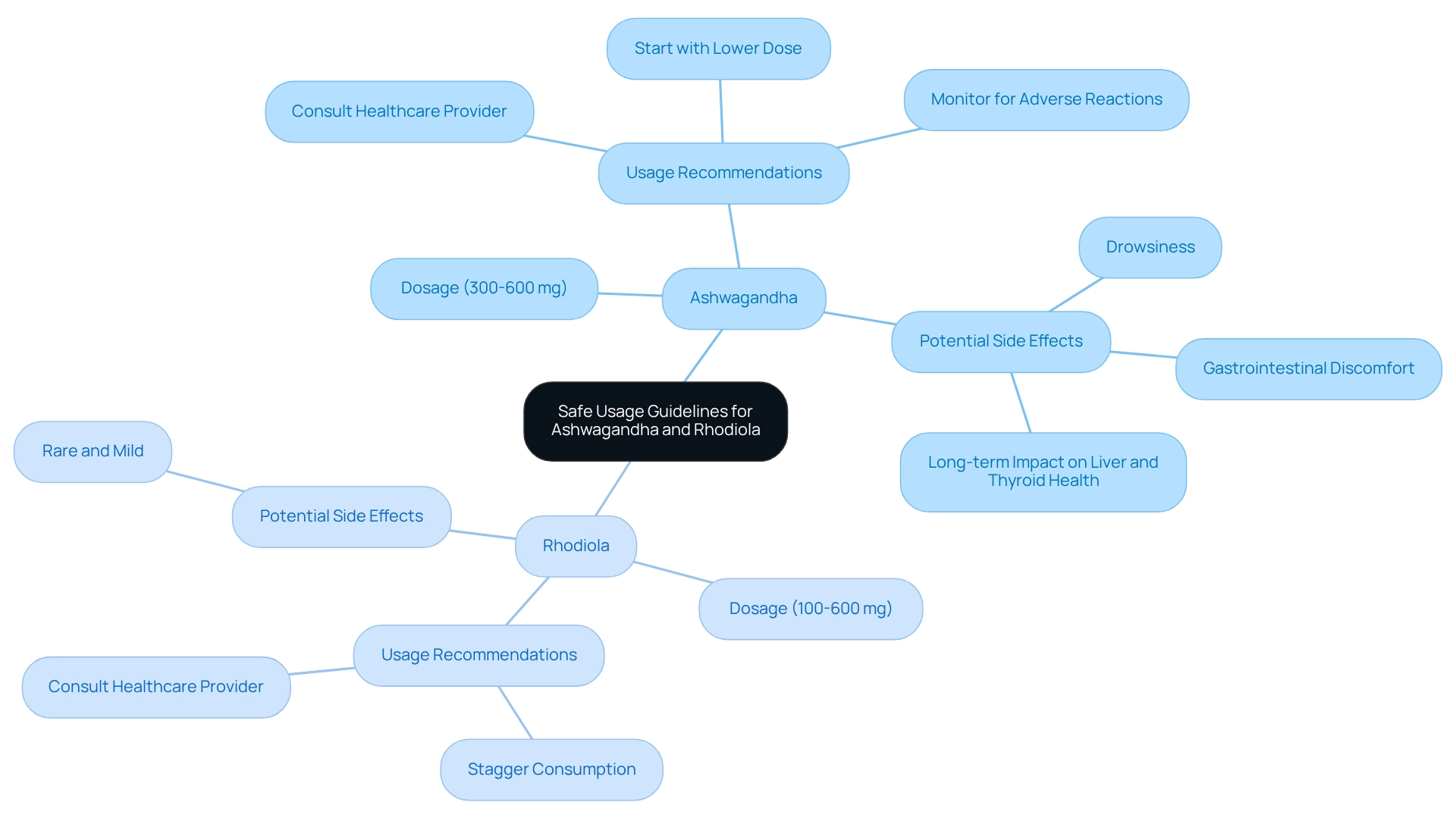Mastering Ashwagandha and Rhodiola for Stress Relief
Overview
The article explores the effective use of ashwagandha and rhodiola for stress relief among healthcare professionals operating in high-stress environments. It highlights the stress-reducing properties of these adaptogens, providing safe usage guidelines and underscoring the importance of consulting healthcare providers. This approach emphasizes their potential to enhance mental health and bolster resilience against burnout. By understanding these natural remedies, healthcare professionals can better navigate the challenges of their demanding roles.
Introduction
In the high-pressure realm of healthcare, professionals often grapple with relentless demands, long hours, and emotional strain. This leads to a concerning rise in stress and burnout. Understanding the nuances of these challenges is vital, as their consequences can extend beyond the workplace, impacting both mental and physical health. By recognizing the symptoms of burnout and implementing effective stress management strategies, healthcare workers can foster resilience and enhance their ability to deliver quality care.
Utilizing adaptogens like ashwagandha and rhodiola offers promising benefits. These powerful herbs can help mitigate stress and improve well-being. This article delves into the critical aspects of stress in the healthcare sector, the advantages of these adaptogens, and essential guidelines for their safe use. Ultimately, it offers a pathway to improved well-being for those dedicated to caring for others.
Understand Stress and Burnout in the Health-Care Industry
The medical sector is notorious for its high-stress environment, where professionals often confront long hours, emotional strain, and the relentless pressure of patient care. Stress and burnout can lead to significant health issues, including anxiety, depression, and physical ailments. Understanding the symptoms of burnout—such as emotional exhaustion, depersonalization, and reduced personal accomplishment—is essential for healthcare workers. By identifying these signs, individuals can be encouraged to pursue effective pressure management techniques. Adaptogens such as ashwagandha and rhodiola have been shown to improve mental health and resilience in difficult situations.
As of 2025, the East South Central region reported an 11.7% decrease in professional stress from 2020 to 2023. This indicates that effective stress management strategies can yield positive results. Expert insights, including those from David C. Mohr, PhD, highlight the significance of maintaining advancements in worker well-being in the post-pandemic environment. He observes, “As medical organizations proceed in the postpandemic phase, it remains crucial to discover methods to maintain and support enhancements in health worker well-being and diminish burnout at work.”
Furthermore, prioritizing employee feedback in policy and procedure management is crucial for addressing burnout effectively. A significant case study concerning the Veterans Health Administration (VHA) emphasized the importance of employee feedback systems in evaluating burnout and tension levels. By regularly collecting feedback, the VHA was able to implement targeted interventions that significantly improved workplace conditions and employee well-being. This continuous conversation underscores the essential requirement for healthcare practitioners to identify tension and pursue effective remedies, such as ashwagandha and rhodiola, to build resilience and improve their ability to deliver quality care.

Explore the Benefits of Ashwagandha and Rhodiola for Stress Relief
Ashwagandha (Withania somnifera) is renowned for its ability to lower cortisol levels, the hormone primarily responsible for stress. Research has shown that this herb can significantly reduce stress and anxiety, fostering a sense of calm and well-being. However, it is crucial to recognize that the French Agency for Food, Environmental, and Occupational Health and Safety has advised against the use of this herbal supplement in certain populations. Additionally, it may interact with thyroid hormone medications and other drugs, including:
- antidiabetes medications
- antihypertensives
- immunosuppressants
- sedatives
Furthermore, in 2023, Denmark prohibited the use of ashwagandha due to concerns over its potential abortifacient properties and interactions with thyroid and sex hormones. This indicates a growing caution regarding its safety, particularly for at-risk groups such as expectant mothers.
On the other hand, Rhodiola rosea is celebrated for its energizing properties, enhancing mental clarity and reducing fatigue. It aids the body in adapting to stress by improving mood and cognitive function. Together, ashwagandha and rhodiola create a harmonious response, providing both soothing and invigorating benefits that can help individuals manage stress more effectively. Research suggests that the combination of ashwagandha and rhodiola can lead to improved mood stabilization and enhanced overall well-being. Notably, five studies investigating the effects of ashwagandha on anxiety levels demonstrate a substantial overall decrease in stress (pooled effect size: −4.72, 95 % CI: −8.45 to −0.99). Furthermore, expert opinions from herbalists underscore the importance of this herb in stress management, reinforcing its role as a valuable ally in promoting mental health.

Implement Safe Usage Guidelines for Ashwagandha and Rhodiola
When evaluating herbal supplements like rhodiola, it’s crucial to adhere to suggested dosages. This practice enhances the benefits while minimizing potential hazards. For ashwagandha, a typical dosage ranges from 300 to 600 mg of standardized extract per day. In contrast, rhodiola is often taken in doses of 100 to 600 mg daily. It’s advisable to start with a lower dose and gradually increase it to assess tolerance.
Both herbs can be consumed simultaneously; however, staggering their consumption throughout the day is recommended to maximize their benefits. Additionally, consulting with a healthcare provider before starting any new supplement is essential, especially for individuals who are pregnant, nursing, or taking medications that may interact with these herbs. Observing for adverse reactions, such as gastrointestinal discomfort or drowsiness, is also vital to ensure a positive experience.
Notably, the potential side effects of Rhodiola Rosea are rare and typically mild. Furthermore, while ashwagandha has demonstrated stress-relieving properties, the long-term impact of ashwagandha on liver function and thyroid health requires further investigation. It’s also worth mentioning that Rhodiolife has received approval and a Natural Product Number from Health Canada, which permits several health claims related to stress relief and cognitive function. By following these guidelines, individuals can safely explore the advantages of these adaptogens.

Conclusion
The healthcare industry is currently navigating unprecedented challenges, with stress and burnout increasingly affecting professionals. Recognizing the symptoms of burnout is crucial, as it empowers healthcare workers to pursue effective stress management strategies. Adaptogens such as ashwagandha and rhodiola emerge as valuable allies in this endeavor, offering significant benefits in reducing stress and enhancing resilience. By understanding the importance of these herbs and adhering to safe usage guidelines, healthcare professionals can cultivate a healthier work environment.
The evidence supporting the effectiveness of ashwagandha in lowering cortisol levels and promoting well-being is compelling. Additionally, rhodiola’s energizing properties complement its calming effects. Together, these adaptogens create a powerful synergy, enabling healthcare workers to manage stress more effectively and maintain their mental health.
Ultimately, prioritizing mental well-being in the healthcare sector is not merely beneficial for individual practitioners; it is essential for delivering high-quality patient care. By embracing stress management strategies and utilizing adaptogens, healthcare professionals can enhance their resilience, improve their overall health, and continue to provide the compassionate care that patients deserve.
Frequently Asked Questions
What are the main causes of stress and burnout in the healthcare industry?
The healthcare industry is characterized by long hours, emotional strain, and the relentless pressure of patient care, all of which contribute to high levels of stress and burnout among professionals.
What are the symptoms of burnout that healthcare workers should be aware of?
Symptoms of burnout include emotional exhaustion, depersonalization, and a reduced sense of personal accomplishment.
How can healthcare workers manage stress and burnout effectively?
Healthcare workers can manage stress and burnout by identifying signs of burnout and pursuing effective pressure management techniques, such as utilizing adaptogens like ashwagandha and rhodiola, which have been shown to improve mental health and resilience.
What recent trends have been observed in professional stress levels in the healthcare sector?
As of 2025, the East South Central region reported an 11.7% decrease in professional stress from 2020 to 2023, indicating that effective stress management strategies can yield positive results.
Why is employee feedback important in addressing burnout in healthcare settings?
Prioritizing employee feedback is crucial for effectively addressing burnout, as it allows organizations to evaluate burnout and tension levels and implement targeted interventions to improve workplace conditions and employee well-being.
What case study highlights the importance of employee feedback in managing burnout?
A significant case study concerning the Veterans Health Administration (VHA) emphasized the importance of employee feedback systems in evaluating burnout and tension levels, which led to targeted interventions that improved workplace conditions and employee well-being.
What expert insights are available regarding worker well-being in the post-pandemic healthcare environment?
Experts, including David C. Mohr, PhD, emphasize the importance of maintaining advancements in worker well-being in the post-pandemic environment and finding methods to support health worker well-being and reduce burnout at work.






